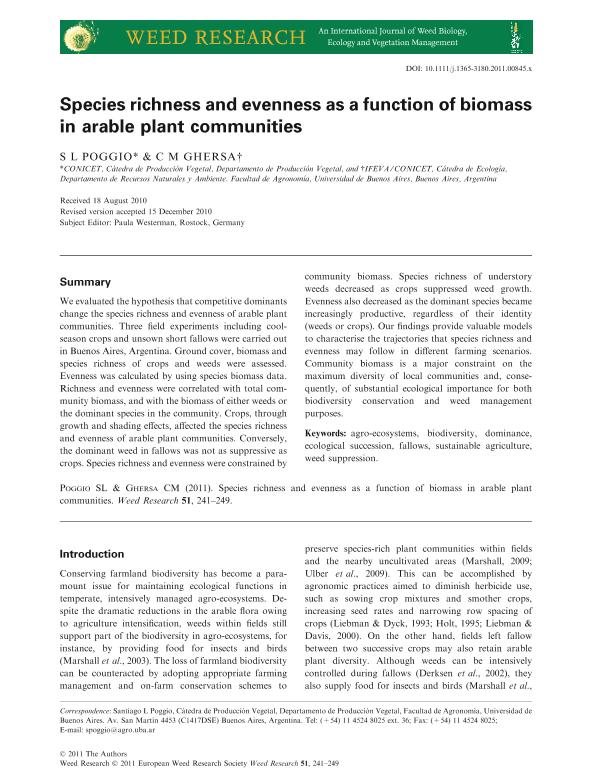Mostrar el registro sencillo del ítem
dc.contributor.author
Poggio, Santiago Luis

dc.contributor.author
Ghersa, Claudio Marco

dc.date.available
2020-02-07T22:31:24Z
dc.date.issued
2011-06
dc.identifier.citation
Poggio, Santiago Luis; Ghersa, Claudio Marco; Species richness and evenness as a function of biomass in arable plant communities; Wiley Blackwell Publishing, Inc; Weed Research; 51; 3; 6-2011; 241-249
dc.identifier.issn
0043-1737
dc.identifier.uri
http://hdl.handle.net/11336/96988
dc.description.abstract
We evaluated the hypothesis that competitive dominants change the species richness and evenness of arable plant communities. Three field experiments including cool-season crops and unsown short fallows were carried out in Buenos Aires, Argentina. Ground cover, biomass and species richness of crops and weeds were assessed. Evenness was calculated by using species biomass data. Richness and evenness were correlated with total community biomass, and with the biomass of either weeds or the dominant species in the community. Crops, through growth and shading effects, affected the species richness and evenness of arable plant communities. Conversely, the dominant weed in fallows was not as suppressive as crops. Species richness and evenness were constrained by community biomass. Species richness of understory weeds decreased as crops suppressed weed growth. Evenness also decreased as the dominant species became increasingly productive, regardless of their identity (weeds or crops). Our findings provide valuable models to characterise the trajectories that species richness and evenness may follow in different farming scenarios. Community biomass is a major constraint on the maximum diversity of local communities and, consequently, of substantial ecological importance for both biodiversity conservation and weed management purposes.
dc.format
application/pdf
dc.language.iso
eng
dc.publisher
Wiley Blackwell Publishing, Inc

dc.rights
info:eu-repo/semantics/openAccess
dc.rights.uri
https://creativecommons.org/licenses/by-nc-sa/2.5/ar/
dc.subject
AGRO-ECOSYSTEMS
dc.subject
BIODIVERSITY
dc.subject
DOMINANCE
dc.subject
ECOLOGICAL SUCCESSION
dc.subject
FALLOWS
dc.subject
SUSTAINABLE AGRICULTURE
dc.subject
WEED SUPPRESSION
dc.subject.classification
Agricultura

dc.subject.classification
Agricultura, Silvicultura y Pesca

dc.subject.classification
CIENCIAS AGRÍCOLAS

dc.title
Species richness and evenness as a function of biomass in arable plant communities
dc.type
info:eu-repo/semantics/article
dc.type
info:ar-repo/semantics/artículo
dc.type
info:eu-repo/semantics/publishedVersion
dc.date.updated
2020-02-07T13:48:38Z
dc.journal.volume
51
dc.journal.number
3
dc.journal.pagination
241-249
dc.journal.pais
Reino Unido

dc.journal.ciudad
Londres
dc.description.fil
Fil: Poggio, Santiago Luis. Consejo Nacional de Investigaciones Científicas y Técnicas. Oficina de Coordinación Administrativa Parque Centenario. Instituto de Investigaciones Fisiológicas y Ecológicas Vinculadas a la Agricultura. Universidad de Buenos Aires. Facultad de Agronomía. Instituto de Investigaciones Fisiológicas y Ecológicas Vinculadas a la Agricultura; Argentina
dc.description.fil
Fil: Ghersa, Claudio Marco. Consejo Nacional de Investigaciones Científicas y Técnicas. Oficina de Coordinación Administrativa Parque Centenario. Instituto de Investigaciones Fisiológicas y Ecológicas Vinculadas a la Agricultura. Universidad de Buenos Aires. Facultad de Agronomía. Instituto de Investigaciones Fisiológicas y Ecológicas Vinculadas a la Agricultura; Argentina
dc.journal.title
Weed Research

dc.relation.alternativeid
info:eu-repo/semantics/altIdentifier/doi/http://dx.doi.org/10.1111/j.1365-3180.2011.00845.x
dc.relation.alternativeid
info:eu-repo/semantics/altIdentifier/url/https://onlinelibrary.wiley.com/doi/abs/10.1111/j.1365-3180.2011.00845.x
Archivos asociados
